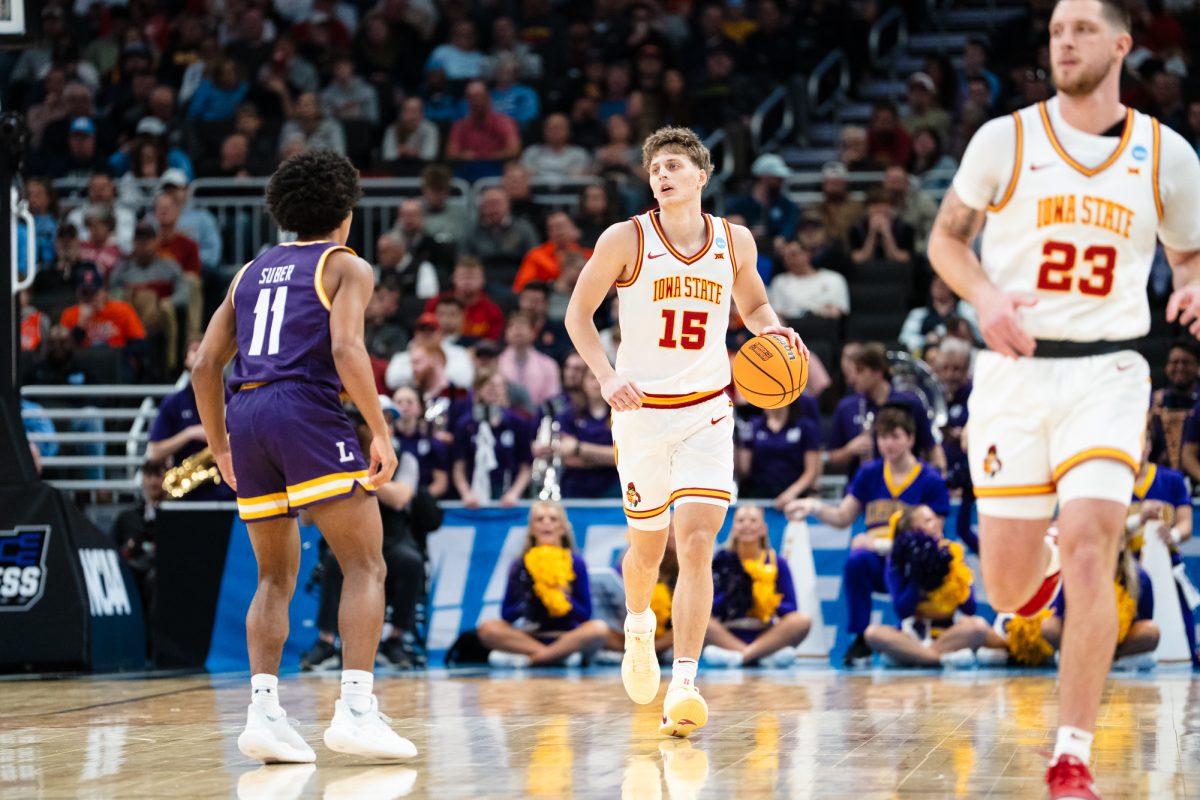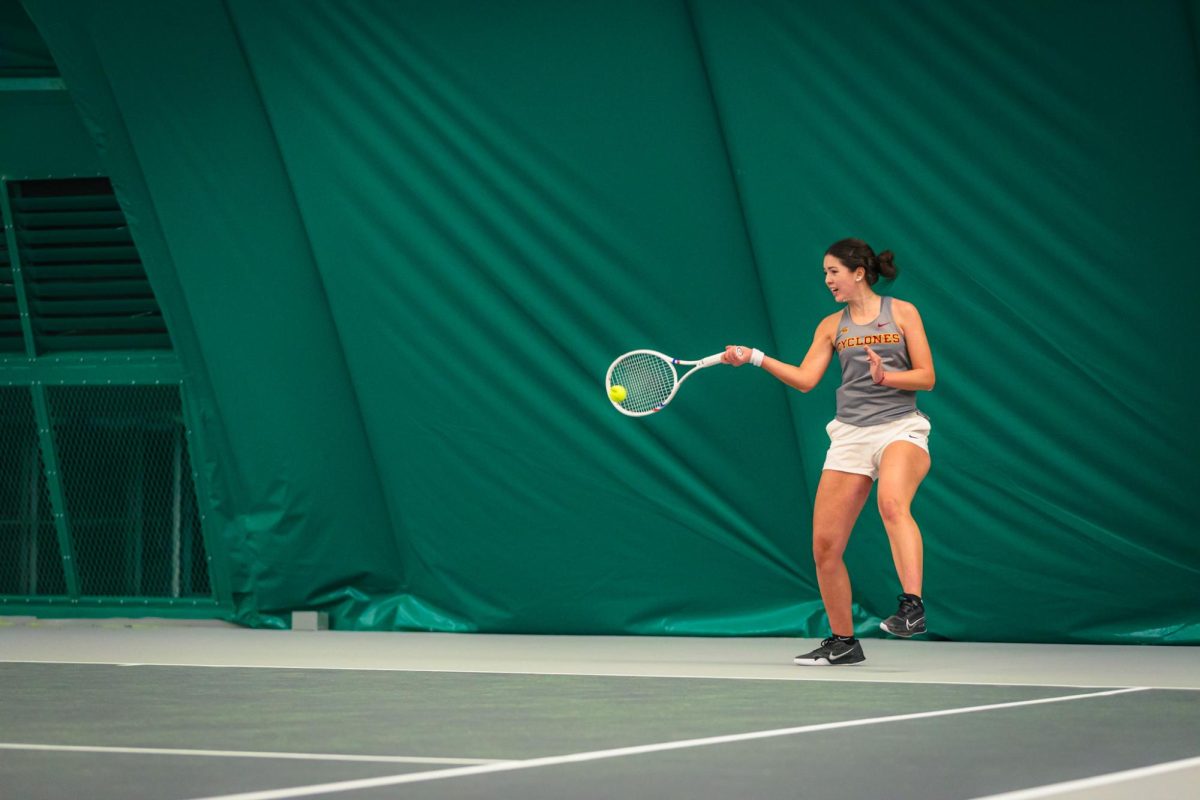Hilton says goodbye to Hogue
March 11, 2015
The hordes of ISU faithful—more than 14,000 strong—take jubilantly to their feet in celebration and awe of the impossible comeback they are witnessing. A low rumble begins to emanate from somewhere inside the arena. At first, the message is unclear.
Dustin Hogue stands on the sideline and gazes out across the Hilton hardwood upon which he’s built his name—the setting of a legacy he once thought unlikely to ever be written.
For Hogue, this is hallowed ground.
The rumbling grows louder. A rhythmic, pounding roar emerges from the chaos of random noise as the fans’ bellows and shrieks meld into one voice, thundering in unison.
“Dustin Hogue! Dustin Hogue! Dustin Hogue! Dustin Hogue!”
The infectious chant pulsates from the floor boards to the rafters. Hilton trembles as the referee tosses the basketball to Naz Long, who finds himself distracted by the stirring marvel growing around him.
Long notices one oration distinctly from thousands. It’s coming from the court. His attention snaps back to the task at hand and that’s when he realizes—the voice is his own.
“Dustin Hogue! Dustin Hogue!” Long chants as he stands at the free-throw line.
A little less than two minutes after the second half against Oklahoma began on March 2, the Cyclones stared up at a seemingly insurmountable 21-point deficit. Roughly 18 minutes and one historic 22-0 run later, Hogue stares up at the beaming jumbotron suspended above center court one last time.
Twenty-nine ticks of the clock remain the ultimate barrier between Hogue and his final curtain call at Hilton. This is not the end, but it is an end. And a glorious one at that.
“Nobody wants to go out in their last game at Hilton with a loss. Being down by 20 and banding together with your brothers, grinding it out and coming back, it was just [crazy],” Hogue said. “Honestly, I don’t think there’s a better way to end your college career at Hilton. I actually had a game where the magic was in effect, and that was definitely the way to go out.”
The symmetry between Hogue’s final contest in Ames and how he came to be a Cyclone in the first place is impossible to ignore. Iowa State’s 21-point comeback victory tied a school record and was the largest margin overcome in a game by any team in the nation this season. To call the win improbable would be an understatement.
A New Yorker born and bred, Hogue knew nothing of Iowa before setting foot on the campus of Indian Hills Community College in Ottumwa. If he had, he probably would never have ended up there. Hogue’s talent was overlooked in the Northeast, and as he searched for smaller scale opportunities, a coach at Indian Hills convinced him that central Iowa really wasn’t all that different from New York City.
Despite being sold a tale that would tower above any skyscraper in the Big Apple, Hogue decided to play two years at Indian Hills. During those seasons, he met ISU coach Fred Hoiberg for the first time. Even that was essentially an accident.
“When we went to recruit at Indian Hills, we were there to see Jameel [McKay], and Dustin was a guy that really stood out to us,” Hoiberg said. “We were very fortunate to get him.
“To see the way that he has evolved as a player and a leader has been awesome.”
Perhaps it was fate that called Hogue to Iowa State. Perhaps it was merely coincidence. Either way, Hoiberg wasn’t the only one who felt fortunate as Hogue’s career inside Hilton drew to a close.
“For the longest time, I didn’t even think I’d be playing Division I ball,” Hogue said. “The fact that Iowa State has given me this chance to come out and be on a great team, and to have the fans support me when nobody else did, was pretty big for me. I never thought I would have this feeling before and to hear them cheering my name—it was something I’m never going to forget.”
Hogue and his contributions to the ISU basketball program will not be soon forgotten either. A quieter and more reserved individual than most, Hogue lets his play do most of the talking.
He has started each of his 66 games in the cardinal and gold. He boasts career averages of 11 points, 6.8 rebounds and 1.1 assists per outing. In 2013-14, he nearly led the Big 12 in rebounding from the small forward position, accumulating 8.4 boards per contest. Point guard Monte Morris said that Hogue is flat out the best rebounder he’s played with anywhere, ever.
Yet even more than his in-game production, Hogue’s teammates respect who he is off the court and what he’s been willing to give up for the good of the group.
“It hurts talking about him leaving the program because I feel like the up-trend of this program, he was really a part of it,” said Wooden Award finalist Georges Niang. “He’s just a guy that dedicates his energy, his body, his life into just this team, and that speaks volumes to who he is and how any role coach lays out for him, he’s going to accept it. He’s always answered the bell.”
The most prevalent sacrifice Hoiberg asked Hogue to make in the name of the team was to assume the role of power forward after the departure of Melvin Ejim last season. McKay, Hogue’s former teammate at Indian Hills and now Iowa State’s starting center, was forced to miss the team’s initial eight games due to NCAA transfer regulations.
To begin the season, Hoiberg started a three-guard lineup along with Hogue and Niang in the front court. The ISU coach appreciated the chemistry and success he found with that group and decided to stick with it into the month of February, even after McKay regained eligibility and the appropriate game conditioning.
The role change forced Hogue’s rebounding totals, numbers he prides himself on and which are part of his identity as a player, down from 8.4 per game as a junior to 4.9 as a senior.
“Going against some of the bigger guys in the regular season, I’m not able to just out-jump everybody,” Hogue said. “So I do give up some size and give up a rebound by just committing myself to boxing my guy out and letting somebody like Naz come up with seven rebounds or Monte come up with eight.”
Hogue mentioned before the season being irked that he’d let the Big 12 rebounding title slip through his grasp as a junior, stating one of his primary personal goals as claiming that crown, which he believed should always have been his. However, when the team’s needs changed, so did Hogue’s priorities.
“Sacrificing the rebounds kind of hits people hard, but it’s for the greater good of the team,” Hogue said. “As long as we win, then I’m fine with having zero rebounds in a game, as long as I know we have other guys getting the rebounds that I would have gotten.”
McKay eventually found his way into the starting lineup, which has pushed Hogue back to his natural position. In his last game at Hilton, Hogue grabbed 10 boards—his first double-digit rebounding effort since Iowa State played Iowa at Carver-Hawkeye arena on Dec. 12.
Hogue said that during his final run through the ranks of collegiate basketball, ISU fans can expect him to return to the player they were first introduced to in 2013.
“I have to get back to my roots and start rebounding the ball again, because when I rebound there’s no second chance points, and that stops everything the other team is trying to accomplish,” Hogue said. “If I’m out there defending and rebounding, I think we’ll be fine.”
The transition back will be difficult absent the familiar confines of Hilton, where Hogue’s basketball roots were first laid down on the grandest of scales. He said he knows it won’t be easy, but Hogue has never been one to back down from any challenge.
That’s simply not the man he is. That’s not part of the legacy he’s built.
“Looking at some of the pictures and some of the game film when we were actually on the Hilton floor—knowing I won’t be able to be out there again did kind of hit me hard,” Hogue said. “But I just know, there’s a lot more basketball to be played.”






